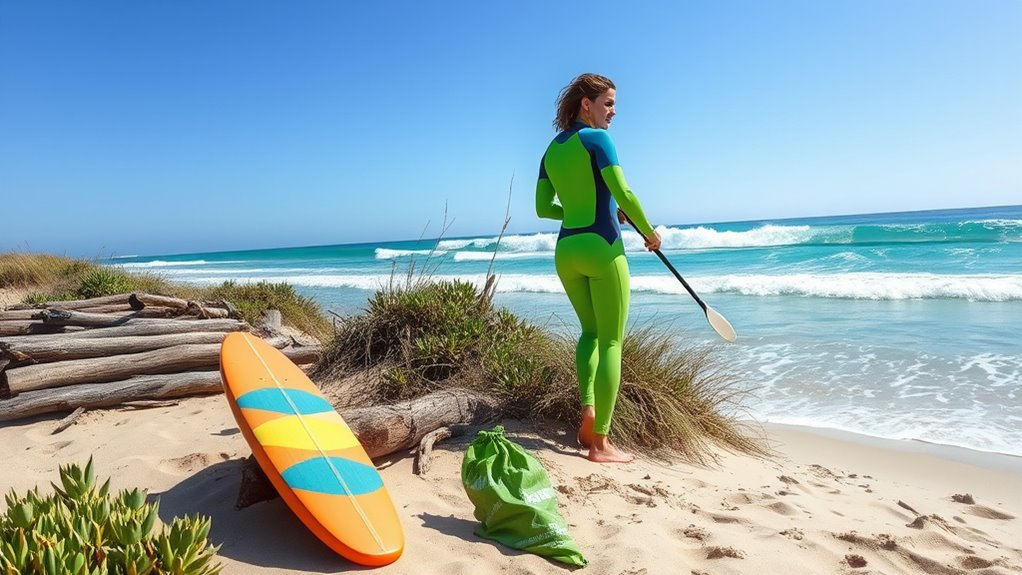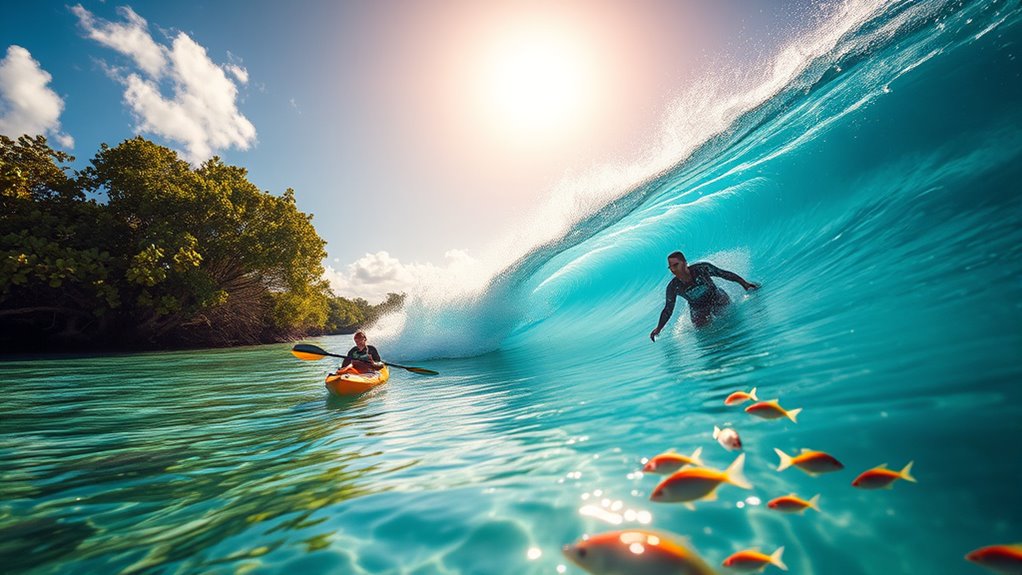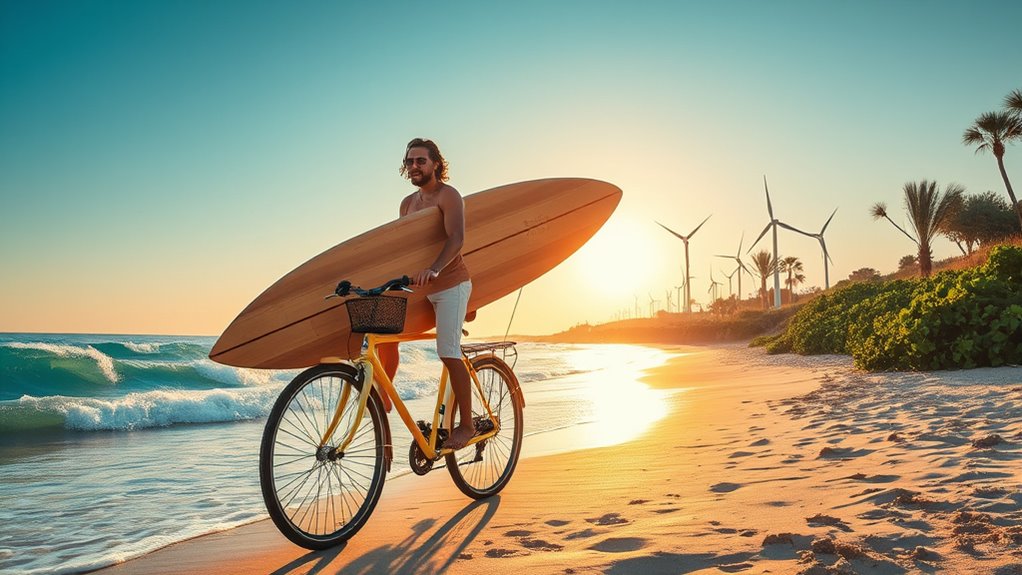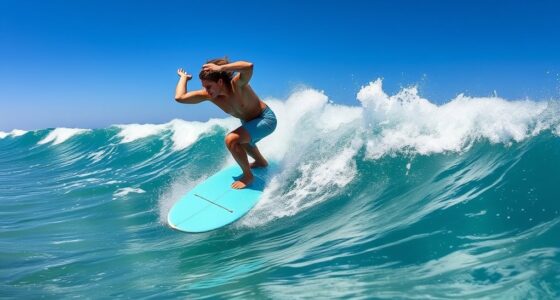To practice eco-friendly surfing, choose gear made from recycled and sustainable materials, and avoid plastic packaging. Respect marine life by steering clear of protected areas and handling wildlife gently. Reduce waste by carrying reusable containers and participating in beach cleanups. Use eco-friendly sunscreens, support conservation projects, and opt for green transportation like biking or carpooling. Practice good surf etiquette to protect surf spots and ensure everyone’s safety. Keep exploring to learn more about preserving our oceans and waves.
Key Takeaways
- Choose surfboards and gear made from recycled or eco-friendly materials to reduce environmental impact.
- Practice responsible surfing by avoiding coral reefs, respecting local regulations, and maintaining wave etiquette.
- Minimize waste by using reusable containers, participating in beach cleanups, and properly disposing of trash.
- Support marine protected areas and eco-conscious tourism to help conserve ocean ecosystems.
- Use sustainable transportation options like biking, walking, or carpooling to lower carbon emissions.
Choosing Sustainable Surf Gear

When selecting surf gear, opting for sustainable options helps reduce your environmental impact. Choose equipment made from recycled materials, such as recycled plastics or foam, to minimize waste. Look for surfboards and accessories that utilize eco-friendly materials, which often have a lower carbon footprint. Additionally, prioritize products packaged in biodegradable packaging, which breaks down naturally and doesn’t contribute to pollution. By making these conscious choices, you support manufacturers committed to reducing plastic waste and conserving resources. Sustainable surf gear not only benefits the environment but also encourages industry shifts towards greener practices. Remember, your selection can influence market trends and promote a more eco-conscious surfing community. Small changes in your gear choices make a significant difference for the planet.
Respecting Marine Life and Local Ecosystems

Have you ever considered how your surfing habits impact marine life and local ecosystems? When you enter the water, you become part of a delicate marine habitat that supports a rich aquatic biodiversity. Respecting this environment means avoiding contact with coral reefs and marine animals, which can cause harm or stress. Stick to designated surf zones and steer clear of protected areas to prevent disturbing fragile ecosystems. Be mindful of the noise and activity levels, as loud or aggressive behavior can scare away wildlife and disrupt their natural routines. By practicing responsible surfing, you help preserve the health of marine habitats, ensuring that future surfers and marine life can coexist harmoniously. Zoning laws and local regulations can influence where you surf and how you do so, so being informed helps protect these vital environments. Your actions directly influence the well-being of the ecosystems that make surfing possible, and adopting eco-friendly practices can significantly reduce your environmental impact. Supporting sustainable tourism initiatives can also promote conservation efforts and responsible use of coastal resources. Additionally, understanding the importance of marine biodiversity emphasizes the need to minimize your ecological footprint while enjoying the ocean. Maintaining environmental awareness is crucial for long-term preservation of these ecosystems and ensuring that surfing remains sustainable for generations to come.
Minimizing Waste and Properly Disposing of Trash

To protect our oceans and beaches, you need to be proactive about minimizing waste and properly disposing of trash while surfing. Carry reusable bags and containers to reduce single-use plastics. Participate in recycling initiatives and ensure trash makes it to proper bins. Composting efforts can be applied to biodegradable waste, like food wrappers or organic materials. Here’s a quick guide:
| Waste Type | Disposal Method |
|---|---|
| Plastic bottles | Recycle in designated bins |
| Food wrappers | Recycle or compost if biodegradable |
| Organic waste | Compost if possible |
Additionally, understanding home furnishings safety and maintenance, like inspecting your gear regularly, can help prevent environmental hazards. Engaging in mindful disposal practices supports sustainable living and reduces your ecological footprint. Incorporating energy-efficient practices into your routine can further minimize environmental impact while enjoying the ocean. Being aware of marine pollution sources and their effects can motivate more responsible behavior during your ocean activities. Proper disposal of hazardous waste such as batteries or chemicals is also essential to prevent contamination of marine environments.
Using Eco-Friendly Sunscreens and Skin Products

Using eco-friendly sunscreens and skin products is essential for protecting both your skin and the environment. Look for products that contain reef safe ingredients, which won’t harm coral reefs or marine life. These sunscreens avoid harmful chemicals like oxybenzone and octinoxate, ensuring you stay protected without damaging delicate ecosystems. Additionally, choose brands that use biodegradable packaging, which breaks down naturally and reduces plastic waste in the ocean. By making these choices, you support sustainable practices and help preserve the beauty of surf spots for future generations. Applying eco-friendly products not only benefits marine life but also minimizes your ecological footprint. Remember, small changes in your skincare routine can make a big difference for the environment you love to surf in. Incorporating eco-friendly ingredients into your routine further enhances your commitment to sustainability.
Supporting Marine Conservation Initiatives

You can make a real difference by participating in beach cleanups and supporting marine protected areas. When you choose sustainable brands, you help reduce pollution and protect ocean ecosystems. Every action counts toward preserving the waters where you surf and enjoy. Incorporating environmentally friendly health and nutrition practices can further contribute to the overall well-being of marine environments. Additionally, understanding the impact of cultural factors promoting individualism can help promote more sustainable attitudes towards ocean conservation. Recognizing how food safety practices influence environmental health can also encourage more eco-conscious choices among surfers and coastal communities. Exploring how artistic practices intersect with environmental activism can inspire innovative approaches to conservation efforts. Engaging in community involvement can amplify conservation initiatives and foster a collective responsibility for protecting ocean health.
Participating in Beach Cleanups
Participating in beach cleanups offers surfers a tangible way to support marine conservation efforts. When you join a beach cleanup, you directly remove ocean debris that threatens marine life and ecosystems. Your efforts prevent trash from washing into the ocean, where it can harm wildlife and damage habitats. By collecting litter, you help restore the natural beauty of beaches, ensuring they remain healthy for future surf sessions. Plus, beach cleanups foster community awareness and inspire others to adopt eco-friendly habits. Every piece of debris you pick up makes a difference, reducing pollution and protecting the ocean environment. Engaging in these activities not only benefits marine life but also aligns with your commitment to sustainable surfing, showing that small actions can lead to significant positive change. Additionally, supporting environmentally responsible practices in your surfing routine helps promote broader conservation initiatives.
Supporting Marine Protected Areas
Supporting Marine Protected Areas (MPAs) is a powerful way to help conserve the ocean’s health and guarantee vibrant surf spots for the future. By advocating for the establishment and proper management of conservation zones, you actively protect critical habitats from overfishing, pollution, and development. These marine protected areas serve as safe havens for marine life, ensuring healthy ecosystems that sustain surf breaks and coastal biodiversity. Your involvement can include supporting policies that expand MPAs, respecting no-take zones, and spreading awareness about their importance. Engaging in marine ecosystem preservation efforts can amplify the positive impact of these initiatives. Additionally, understanding the key components of sound design can help communicate the importance of marine conservation through compelling audio-visual projects. Recognizing the significance of candle sinking issues can also inform sustainable practices in eco-friendly product development, further supporting environmental efforts. Promoting cultural intelligence within conservation initiatives can enhance collaboration with diverse communities and stakeholders. Help identify and promote key conservation zones near popular surf spots, participate in local efforts to expand or enforce marine protected areas, and educate fellow surfers on the benefits of MPAs for sustainable surfing and marine health.
Promoting Sustainable Brands
Promoting sustainable brands plays an essential role in advancing marine conservation efforts that benefit both the environment and the surfing community. By choosing brands that prioritize eco-friendly practices, you support initiatives like recycling surfboards, reducing waste that pollutes oceans. Many companies now create surfboards from recycled materials, making it easier for you to reduce your environmental footprint. Additionally, switching to eco-friendly surf wax minimizes harmful chemicals entering the water, protecting marine life. Your support encourages brands to continue adopting sustainable methods and innovating eco-conscious products. When you purchase from these brands, you’re actively participating in conservation efforts and promoting a culture of sustainability within the surfing community. Together, your choices help preserve the ocean for future generations of surfers. Understanding how WWE Raw’s Financial Impact influences global entertainment underscores the importance of supporting sustainable practices in all industries. Recognizing the significance of relationship-building can further strengthen community efforts towards environmental conservation. Incorporating sustainable materials into product design not only reduces environmental impact but also sets a positive example for others to follow.
Opting for Eco-Conscious Transportation Methods

Choosing eco-conscious transportation methods can considerably reduce your carbon footprint before even reaching the surf spot. By opting for renewable energy-powered options or electric vehicles, you minimize emissions and support sustainable practices. Electric vehicles produce no tailpipe emissions and can be charged using renewable energy sources, making your trip greener. Carpooling with fellow surfers not only reduces the number of vehicles on the road but also fosters community. Additionally, biking or walking to the beach is an excellent way to enjoy the environment while cutting down on emissions. Consider using public transportation whenever possible; many cities offer eco-friendly transit options. These choices show your commitment to protecting the environment and ensure that your surfing experience stays in harmony with nature.
Practicing Responsible Surfing and Respecting Breaks

To guarantee the health of surf breaks and the surrounding environment, you need to practice responsible surfing and respect local rules. Follow proper wave etiquette by waiting your turn, avoiding drop-ins, and respecting other surfers’ space. This helps maintain a positive atmosphere and reduces conflicts. Prioritize surf zone safety by staying aware of your surroundings, avoiding crowded areas, and keeping an eye on beginners or swimmers. Respect the break by not carving out new paths that can damage the reef or seabed. Keep the area clean by disposing of trash properly and minimizing your impact. Practicing responsible surfing not only protects the environment but also ensures a safe, enjoyable experience for everyone in the water.
Educating Others and Spreading Awareness

Educating others and spreading awareness is essential for ensuring that sustainable surfing practices become the norm. You can lead community outreach programs to engage local surfers and residents, highlighting eco-friendly habits. Utilize social media campaigns to share tips on reducing plastic use, protecting marine life, and maintaining clean beaches. By sharing your knowledge and passion, you inspire others to adopt eco-conscious behaviors.
Consider these strategies to deepen your impact:
- Organize beach cleanup events and invite the community to participate
- Create educational content that emphasizes the importance of preserving surf spots
- Collaborate with environmental organizations to amplify your message and reach broader audiences
Frequently Asked Questions
How Can I Identify Truly Eco-Friendly Surf Gear Brands?
When you’re trying to spot truly eco-friendly surf gear brands, look for brand transparency—they openly share their manufacturing processes and sustainability efforts. Check for eco label certifications like FSC, GRS, or B Corp, which verify their eco claims. These indicators show the brand’s commitment to environmental responsibility. By paying attention to transparency and certifications, you can confidently choose brands that prioritize eco-friendly practices, helping protect our oceans and surf spots.
What Are the Best Practices for Avoiding Marine Pollution While Surfing?
Imagine you’re a guardian of the ocean’s delicate dance. To avoid marine pollution, you should minimize your impact by picking up marine debris and disposing of waste properly. Use eco-friendly surf gear that reduces water pollution, avoid single-use plastics, and rinse your board with eco-conscious solutions. By doing so, you protect the waters that cradle your rides, ensuring they stay pristine and vibrant for future waves.
How Can Beginners Start Practicing Eco-Friendly Surfing Habits?
You can start practicing eco-friendly surfing habits by choosing sustainable options. Recycle your surfboards whenever possible and consider using biodegradable wax to reduce plastic waste. Be mindful of your trash and avoid leaving any debris behind on the beach. Additionally, opt for eco-friendly sunscreen and minimize your energy use. These simple steps help protect marine environments while you enjoy surfing, making your hobby more sustainable and enjoyable.
Are There Specific Times of Year to Surf to Minimize Environmental Impact?
Think of surfing like planting a garden; timing is everything. To minimize impact, you should aim for seasonal best practices, usually avoiding peak tourist months. Check tide timing to surf during calmer, less crowded periods, reducing environmental stress. I once surfed during early spring, when beaches were quieter, and the water was clearer—proving that choosing the right time benefits both you and nature.
How Can Surf Communities Promote Sustainability Collectively?
You can promote sustainability by supporting community-led initiatives and surf conservation programs. Encourage your local surf community to organize clean-up events, promote responsible surf gear, and share eco-friendly practices. By working together, you strengthen awareness and foster a culture of respect for the environment. Your collective efforts make a real difference, helping protect surf spots for future generations and ensuring the ocean remains healthy and vibrant for everyone.
Conclusion
By embracing eco-friendly surfing practices, you become a guardian of the ocean’s beauty, ensuring its waves and wildlife thrive for generations to come. Every small action you take is like a drop in the ocean—powerful enough to create ripples of change. So, surf responsibly, respect the environment, and spread awareness. Together, we can turn the tide toward a sustainable future, making every ride not just thrilling, but also kind to our planet.










